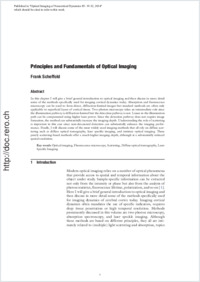Principles and Fundamentals of Optical Imaging
- Scheffold, Frank Department of Physics and Fribourg Center for Nanomaterials, University of Fribourg, Switzerland
-
01.01.2014
Published in:
- Optical Imaging of Neocortical Dynamics. - 2014, vol. 85, p. 19–32
English
In this chapter I will give a brief general introduction to optical imaging and then discuss in more detail some of the methods specifically used for imaging cortical dynamics today. Absorption and fluorescence microscopy can be used to form direct, diffraction-limited images but standard methods are often only applicable to superficial layers of cortical tissue. Two-photon microscopy takes an intermediate role since the illumination pathway is diffraction-limited but the detection pathway is not. Losses in the illumination path can be compensated using higher laser power. Since the detection pathway does not require image formation, the method can substantially increase the imaging depth. Understanding the role of scattering is important in this case since non-descanned detection can substantially enhance the imaging performance. Finally, I will discuss some of the most widely used imaging methods that all rely on diffuse scattering such as diffuse optical tomography, laser speckle imaging, and intrinsic optical imaging. These purely scattering-based methods offer a much higher imaging depth, although at a substantially reduced spatial resolution.
- Faculty
- Faculté des sciences et de médecine
- Department
- Département de Physique
- Language
-
- English
- Classification
- Physics
- License
-
License undefined
- Identifiers
-
- RERO DOC 231810
- DOI 10.1007/978-1-62703-785-3_2
- Persistent URL
- https://folia.unifr.ch/unifr/documents/303865
Statistics
Document views: 128
File downloads:
- pdf: 246
